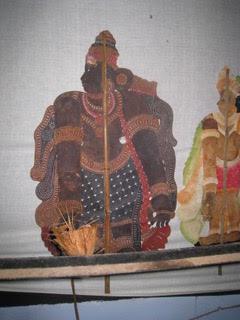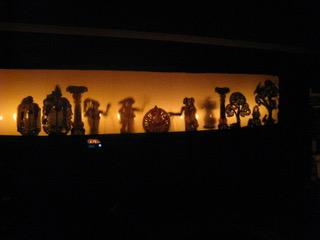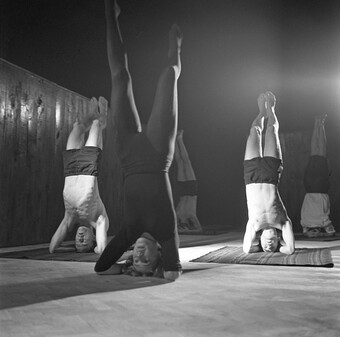Theatre History Podcast #57
Dr. Claudia Orenstein on the Evolving Art of Tolpavakoothu
Tolpavakoothu is a traditional form of shadow puppetry from Kerala, in southern India. Like many similar performance traditions, tolpavakoothu faces an uncertain future because of social and cultural changes. However, it’s facing up to those challenges in some unique ways. Dr. Claudia Orenstein of Hunter College joins us to explain what tolpavakoothu is, and to introduce us to the Pulavars, the family of puppeteers who are finding new and surprising ways to keep their tradition alive while bringing it into the twenty-first century.

Picture courtesy of Claudia Orenstein.
Links:
- Explore the world of tolpavakoothu on Ramachandra Pulavar’s website.
- Watch Borrowed Fire, a documentary on the Pulavars and tolpavakoothu.
- Visit India’s section on the website of UNIMA, the international union of puppetry.
- Read the World Encyclopedia of Puppetry’s entry on India’s various puppetry traditions.
- Learn about “Indian Puppets: The Great Stories and Dancing Dolls,” an exhibition at the Center for Puppetry Arts in Atlanta.
- Learn more about Claudia and her artistic and scholarly work at her personal website.

Additional Reading:
- Claudia’s works includes:
- “Finding the Heart of Indian Puppetry,” in Puppetry International 36 (2014): 16-19.
- The Routledge Companion to Puppetry and Material Performance, edited by Dassia N. Posner, Claudia Orenstein, and John Bell.
- “Women in Indian Puppetry: Artists, Educators, Activists,” in Gender, Space and Resistance: Women and Theatre in India, edited by Anita Singh.
- “Women in Indian Puppetry: Negotiating Traditional Roles and New Possibilities,” (paywall) in Asian Theatre Journal. 32.2 (2015): 493-517.
- Inside the Drama-House: Rama Stories and Shadow Puppets in South India, by Stuart H. Blackburn.
- Puppetry: A World History, by Eileen Blumenthal.
- Indian Puppetry and Puppet Stories, by Sampa Ghosh and Utpal Kumar Banarjee.
- Indian Puppets, by Sampa Ghost and Utpal Kumar Banarjee.
- Kaṭhputli: The World of Rajasthani Puppeteers, by Nazir Ali Jairazbhoy.
- Living Dolls: Story of Indian Puppets, by Jiwan Pani.
- Putual Yatra: An Exhibition of Indian Puppets, presented by the Sangeet Natak Akademi.
- “If Gandhi Could Fly … Dilemmas and Directions in Shadow Puppetry of India,” by Salil Singh in TDR: The Drama Review, Fall 1999.
- Puppetry and Lesser Known Dance Traditions of Kerala, by G. Venu.
- Tolpava Koothu: Shadow Puppets of Kerala, by G. Venu.
You can subscribe to this series via Apple iTunes, Google Play Music, or RSS Feed or just click on the link below to listen:
Transcript:
Michael Lueger: The Theatre History Podcast is supported by HowlRound, a knowledge commons by and for the theatre community. It's available on iTunes and howlround.com.
Hi, and welcome to the Theatre History Podcast. I'm Mike Lueger. How do you keep a tradition alive, while also making sure that it stays relevant to present-day interests and concerns? That's a crucial question facing India's traditional puppeteers. Today we're joined by Dr. Claudia Orenstein, who's been studying Indian puppetry and learning about how it's adapting to changing circumstances. Claudia is a professor of theatre at Hunter College, and she's the co-editor of The Rutledge Companion to Puppetry and Material Performance. Claudia, thank you so much for joining us.
Claudia Orenstein: Oh, thank you so much. I'm really happy to be here.
Michael: What role does puppetry play in various Indian performance cultures, and what are some particularly noteworthy examples?
Claudia: Yes, well, first I think it's useful to know that India has an enormous number of traditions. There maybe are about twenty traditions in every form. That's shadow puppets, rod puppets, string puppets, so there's really a lot of these traditions, and many of them go back a long way. One of the main and important thing, I think, about them is that they really have been used to tell all the epic stories, so the stories of the Ramayana, the stories of the Mahabharata, these are the Hindu epics that are not just stories or tales or myths. We can use those terms. They're the religious foundations of Hinduism and they're stories that are used to think about moral actions, for example, or to deal with important philosophical questions, so the puppeteers have had, in India, this role of presenting these important tales. Also stories about Krishna and other gods, so they've really been part of the fabric of the culture.
There are a lot of different traditions, and there are some traditions, for example in Rajasthan, there's a tradition of string puppetry, which is probably the tradition everybody thinks of when they think of Indian puppets. It's the most emblematic kind of puppet, and these puppeteers were itinerant performers for a long part of their history and did shows about Amar Singh, who was a kind of political figure under the Raj at the time, and so it's more of a history kind of political story, rather than a religious myth or Hindu kind of story. So there are different ways that puppets have been used, but they've always been really an important part of community life. Certainly being performed at festivals and temple festivals, and a rich part of the culture.
I also wanted to mention that there are many traditions in India that I would call kind of object performances, that aren't necessarily puppets, like scroll singing. For example, in West Bengal, there is a tradition of a whole community of people who paint these beautiful scrolls, and sing tales while showing the pictures, and those have been local folk stories as well as religious stories, and more recently, they've been painting stories about things like the tsunami and 9/11 even. I saw several scrolls that had images of George Bush and Osama bin Laden incorporated into them. They've become very popular for tourists to buy these scrolls right now. In Rajasthan, there's a tradition called "Pabuji Ki Phad," which is also a scroll singing tradition. In this tradition, the performers use a very large kind of drop, like a cloth drop with a lot of pictures painted on it, and point to different pictures as they sing parts of the story about Pabuji, who's a local hero for saving cattle in a place that really relies on cattle. So there are really a variety of traditions, but a lot of them are these traditions that do stories of the Ramayana and the Mahabharata.
Michael: So today we're focusing on one particular Indian puppetry tradition, called Tolpavakoothu. Can you tell us a little bit about it?
Claudia: Tolpavakoothu is a shadow puppet tradition, leather puppets, that comes from Kerala, which is in the south of India. It has a very long history, goes back around 1200 years, supposedly. It's always difficult to date these things in India, but that's what it's reported to go back that far, and again, these puppeteers tell the story of the Ramayana. What's unique about this tradition ... I think there are several unique things about it, but one of the things is that it's performed at the temples as part of temple festivals and ceremonies. It can take anywhere from seven to twenty-one nights of performances to tell this whole story, and different temples will request a seven-night versions or a fourteen-night version, depending on really how much money they have to pay the performers to come for how long they want the performance, but the performance can be told over twenty-one nights.
There are special houses for the puppeteers that are permanent structures that are built at the temple grounds and across from the temple of Bhadrakali, and the houses themselves, I'll just say to kind of describe them, is that they're very long and small, and they're empty inside, and the puppeteers stay inside but the people watch outside. They sit on the ground outside, and the front of the house has a long opening where the shadow screen is pulled across, and the screen is very long and thin. It's not a square screen, it's like a long, rectangular screen, and within the shadow house, the puppeteers, also they sleep there, they stay there. When they're doing a twenty-one-night performance, they might stay over. We went and visited the puppeteers at a performance where they were only starting their performance today. I don't think this would have happened in the past, but they were only starting at 4:00 a.m., so they were there, because there was a big festival before that, and they were sleeping until it was time for them to perform. So they occupied a house but the audiences sit outside, and they manipulate the shadows from inside, and they have a long bar behind the screen where they place coconut shells, and within the halved coconut shells, they put coconut oil and they light those up across the screen, and that's how you get the light for the shadows.
The puppet house is always placed right across from the temple so that Bhadrakali, the goddess, can watch the show, because she is actually the primary audience member for this performance. The story goes, the legend is that she's a goddess, Bhadrakali's a goddess and she killed this demon in battle, and the story goes that as she was fighting the demon, she missed the part of the Ramayana event where Rama kills Ravana, the ogre who has stolen away his wife, and he's defeated in battle. She missed that event, and so the puppeteers perform the story of the Ramayana for her, so she can witness the battle that she missed. So that's the story of why they do this performance, and why she is the primary audience member. It's a kind of interesting situation because today, if you were talking about this question of how you preserve a tradition and keep it relevant today, the audiences have really dwindled, the live audiences for the performances ... I wanna say, for the performances at the temples, because one of the interesting things about the tradition is the way it's finding new ways to continue.
But the performances at the temple, especially if something starts at 4:00 a.m., or even a little earlier, people have jobs to go to. They're not living on the agricultural schedule that they used to be. They really have nine-to-five schedules and so they can't be up all night watching all the performances. There are also a lot of different entertainments and things drawing our attention these days. They can go to the movies. They can watch television. There's all of the internet, so that central place that these long performances, twenty-one nights in a row, had played in the cultural life has really shifted. The live audiences have really dwindled, sometimes to nobody, but the goddess is always the main audience, so the performances continue, and the temples continue to host them and support them, because there are a lot of blessings that come from supporting the performance of this shadow puppetry form.
Michael: Now, I don't know whether you've attended a full twenty-one-night performance, but it is my understanding that you've seen a number of performances of Tolpavakoothu, and I really would just love to hear, what are they like?
Claudia: Okay. Well, no, I have to say, sadly, I haven't attended all twenty-one nights. I have seen a number of them, and also one of the things that I might mention here that the puppeteers have done as a way of kind of expanding their tradition, is created a very cut-down, like one-hour version that they can take to puppetry festivals, that they perform at their home in Kerala. People can commission to go to see them and organize to go see these events, so they'll be very happy that I'm advertising that for them, and you can see a lot of the highlight events in that one hour, the things that maybe are most exciting to watch.
So the puppets, it starts with Ganesha, the puppet of Ganesha, which is the elephant-headed god, and pretty much all the puppet tradition ... I would say most of the Hindu puppet tradition in India start with some kind of invocation to Ganesha. Ganesha is the remover of all obstacles, and so it's a wonderful thing to pray to Ganesha before you perform, so you can have a good show, a good presentation without any of the obstacles coming in, and he can bless the performance and you honor Ganesha as a god. So he appears on the screen and it's good to know that the shadow puppets, they're made out of very thick leather, and they're traditionally painted with colors that are made from local plants and local materials, and they have very earthy kind of tones, and the kind of reds and yellows actually come through the screen. You can see them, and I think people are always surprised about that, but there are a lot of shadow puppet traditions where it's not just black shadow. You're seeing actually a lot of the color, and the flames you see flickering behind, and the flames help to kind of bring out those colors, I think. And there are some dancing women along with this benediction to Ganesha, and then we start to tell the story.
There are all kinds of scenes. The puppets, I should also say, have intricate patterns carved into them. One of the things to think about, if you're thinking about shadow puppetry at all, is to kind of ... I sometimes teach courses where we make shadow puppets, and you have to kind of shift your thinking about what you're making when you make a shadow puppet, because of course, the only thing you can see on the screen is a shape that's cut out, or a place where light can come through, so you might wanna draw a nice face, but unless you cut out all the elements of that face, you won't see it. To make these puppets as exciting and vibrant as possible, these puppets have these intricate patterns carved into them of different kinds of shapes, and they're really ornamental, so especially the figures of Rama, who is the kind of ideal king in this Hindu epic and Hindu understanding, has a very ornate outfit, and these are carved with the kind of metal pieces that have shapes at the end, and you take a hammer and you punch them into the leather, and I've been extremely ... We've tried it. I've tried it. I've brought my students. We've all tried it out, and it's really impressive to watch the puppeteers who make these puppets do them, because they are so adept at stamping out these patterns, things that really we struggle with.
But anyway, so you see all these beautiful patterns come through, so I think just to shift our sense of what we're watching when we're watching a shadow show, it's not like we're watching just these dark lumps of silhouettes on the screen. They're very vibrant. They've colorful. They're very ornate. Then, the story is told and behind the screen, there are a lot of puppeteers. The main puppeteer is called the pulavar, and pulavar means "scholar." But in fact, today, the puppeteer's family are the Pulavars, and they're all last name Pulavar. And the whole, you could say, the caste of them, that is, not just their social rank but their job, is to be pulavars. And I think that's an interesting thing that I'm understanding more and more in India and about Hindu culture, that the term "caste" is not just the kind of social class level, which of course it is, but it also refers really to your job. So this caste of people who do these puppet shows, they're pulavars, and they're scholars because they're supposed to know all about these epics and the philosophy and the religious ideas behind them, and during the course of the performance, the other puppeteers, as they're moving the puppets, will be asking the pulavar questions, and the main puppeteer will be giving answers, and sometimes they're very philosophical.
So they're doing a play that's based on a text of the Ramayana that's a Tamil text, Tamil-language text, called the Kamba Ramayana, by the poet Kamban, but over the course of the performance, they don't just say the text. They discuss it. They give insight into it, and the pulavar explains it or tells stories that are related to it that help clarify things, so it's kind of meant to be really a learning experience. Maybe to say some of the highlights about watching it too, so you hear this kind of back and forth all the way along, which is interesting.
Some of the other highlights of what you see ... There are wonderful battle scenes. There'll be puppets that are just of arrows that go back and forth across the screen. In a lot of Hindu stories, the forest is a place that people go to receive enlightenment or have transformational experiences, where they leave the city behind, and this is what happens in the Ramayana. Rama and his brother Lakshmana and his wife Sita all go to the forest, and it's there that Sita is abducted, but they spend a long time in the forest, and they have all kinds of experiences there, and the forest scenes are quite exciting in the puppet show because this puppet tradition has a lot of wonderful animal characters, so there's the beautiful deer that has a neck that's jointed in several places, so you can watch the next go down and go up, and then it spins around because there's a moment when one of the characters turns into a deer and so it spins around and transforms.
There are birds that fly across the screen. There's a snake. So there are all these wonderful animal puppets, and the puppets are moved with rods, and sometimes when a puppet is on the screen for a long time, they just pin it to the screen, and they leave their hands free to move other puppets around, because the screen is just made out of cloth, and they'll take a pin and just pin them there. And some of the characters take several different forms, so you might see the character in one form where it's sitting, and you can see it's sitting on a throne and the only moving part is an arm, but you might see another battle version where both of the arms move, so there are different versions of the characters.
There are also moments of excitement when they throw something on the coconut fires behind the screen, and the fires kind of explode, so you get this kind of special effect. The powder they throw on it, you get these kind of special effects kind of fire igniting behind the screen and that's very exciting. There's a character, I have a puppet of it at home, where they shoot it and its head falls off. So there are all kinds of special effects and events that happen that make the puppetry exciting as well, but a lot of the richness of it is through the telling of the stories and the philosophical repartee, question and answer repartee that goes on between the puppeteers.
Michael: Now, you mentioned the pulavars, and I wanna go back to the question that began this interview, that question about, how do we balance the need to preserve a tradition with the need to make sure that that tradition stays relevant? How are puppeteers like the pulavars addressing that challenge, and is there anything that would help them to do so more effectively?
Claudia: That's a really good question. I'll say that I've been looking at that question. It's a broad question, not just for puppeteers of course, or these Indian puppeteers, puppeteers around the globe, a lot of important performance traditions, you know that there's a whole project through UNESCO of intangible cultural heritage, where they're designating different performance traditions to be important world cultures of intangible heritage. That means it's not something you can preserve by just saying, "Here's a monument and let's keep it." I mean, you can preserve the puppets, but that's not the tradition. You have to preserve all the elements that go into a tradition. Who's being trained, how they're being trained to perform, the ability to perform, opportunities to perform, and audiences to see them, so that it's really a living tradition and not just an archive. So this is a big question for a lot of traditions I'm looking at in different cultures, but pulavars I think have been doing a lot of interesting things.
Years ago, I saw this wonderful movie about the pulavars called "Borrowed Fire," by Salil Singh, a filmmaker. It was really wonderful, and Krishnakutty, the current Ramachandra pulavar, is the current head of the company. His father was in that film when he was quite old, and the film really presents it as a tradition in dire danger, and he's the last puppeteer. I will say that when I saw that movie, which is a beautiful film, my original, initial response was that I wasn't sure that his children were going to continue this tradition when he passed away. It looked like it wasn't something they could really invest in. India's been going through such transformations. It has been, in the past, a country that really dealt with poverty and a lot of transformations and shifts, and today there's a kind of exploding economy, but the way you can survive is by going into business and engineering and computers and a lot of puppeteers have sent their children to go into these other fields, because they couldn't see what relevance it had to keep plugging away at doing a traditional puppetry form, if you could make a real living in computers.
At a time when audiences are dwindling, there are, as we said, other competing things, performances for their attention, other kinds of media competing for their attention, and people moving away from villages and moving to urban centers, so when I saw that film, it looked like this was really a tradition that was in danger. And then, a number of years later, when I was introduced to this company, when I was traveling to India with my students, I realized it was the same company and the father, Krishnakutty had passed away, but his sons, and especially Ramachandra Pulavar, who's the current head of the company, had really taken over the tradition and kind of invested in full force. So not only were they continuing doing the shows at the temples, but they had really tried to cultivate other ways of using the skills that they had to promote the tradition, to continually make it visible outside of the temples, and to become involved with a kind of puppetry culture, and I've known them now for at least ten years, and I've seen some of these projects develop.
For example, they have created puppet shows on Gandhi, and most recently on Jesus Christ. Story of Gandhi, story of Jesus Christ, using all the same techniques that they use in their regular shows, but these are shows not only that they wouldn't do at the temples. They're not for the Hindu goddess, but that are ... There's a lot of interest. Certainly for the Gandhi show for schools, so they can perform at a lot of schools and other kinds of events like that. They developed the show about Jesus Christ with the help of churches. There's a strong Christian population in Kerala, where they're from, so they're invited to perform at these churches, which is a kind of interesting really different thing from performing for the Hindu goddess, but they've been trying to develop new shows, also shows that are maybe on different parts of ... Maybe one tale taken out of the Ramayana or from other Hindu or folk traditions and expand that as something to perform. I've seen them performing at ... There's a festival in Shoranur, which is near where they live, which they have performed at, which is not a temple festival. It's a festival where there's other kinds of performances. There's usually a flower show, and just all sorts of other events.
I remember going to see them one year, and they had a huge audience, of all the people at that festival. It wasn't their regular show. It was a new show that they'd developed, also on a theme from the Hindu epic, taken from Hindu stories, but they were able to have a huge, appreciative audience, so it just gave a different context for their performances, and it really inspired, I would say, Ramachandra's children to be interested in this performance tradition, to care about it and to feel that there was an audience for it. They have partnered with performers who are actors. I saw them do a production where, it was also, again, a story from the Ramayana. Oh, I'm sorry, I think this one was from the Mahabharata. But live actors were doing the main characters, but all the battle scenes were done by the shadow puppeteers in shadow, so that was a different kind of partnership.
They have been recently sponsoring, I've seen, in conjunction sometimes with the Sangeet Natak Akademi this year, which is an important cultural organization in India, it supports puppetry and other arts. But down in Kerala, even before that, I think on their own, they had started this year with the academy, a puppetry festival, where they perform and they introduce puppeteers from other traditions in Kerala and other Indian traditions, they might invite them, and also have been trying some new things. I think Ramachandra's youngest son, Rahul, has been learning other kinds of puppetry, and other kinds of performance. They've been doing things at schools, so they're really kind of expanding. They're brought a design program, students in design from Bangalore who come down, I think now once a year, and do a kind of exchange with them, where they learn puppetry techniques, and they also show the pulavars other kinds of techniques of animation and things like that, so they're trying to branch out to have other kinds of shows that they do, and to show what their skills are and proficiency in puppetry and to spread and promote puppetry in general.
They also make a lot of puppets to sell, and they make other things to sell like keychains and lampshades, using ... They have these amazing leather-carving skills. Those are some of the ways that they've been kind of expanding what they do, and they still do the traditional performances in the traditional way at the festivals, at the temple. So they're able to kind of keep both going.
What I've come to understand is that one of the important challenges that traditional puppeteers have in places like India, is not just these social and economic transformations that they're dealing with, but really what they have to deal with, is a transformation of mindset from a kind of system of patronage, where they have a patron who you can count on to invite you every year, to pay for you, to support you, to being really entrepreneurs within a capitalist system, and that's really the shift that is complicated and exemplified, I think, by a lot of these puppet traditions.
Michael: Now, one other member of the Pulavar family that you've written about, whose work sounds particularly interesting, is Rajita Pulavar. Can you tell us a little bit about her and why she might be so important for the future of Tolpavakoothu?
Claudia: Well, I should say that Ramachandra has three children. Two sons, Rajeev and Rahul, and a daughter, Rajita. Rajeev has really ... I just really wanna say this. He's really starting to take over as the new head of the company, and really delving into everything that's involved with that. Rajita, what's interesting about her involvement in this is that, traditionally, women had nothing to do with this puppet tradition. They weren't allowed to touch the puppets. Most of them didn't even go see puppet performances, and if you go see some of these performances at night at these festivals, right now when the puppeteers perform, it tends to be very late ... early in the day or late in the evening, after a lot of the festivities are over, but those festivals can be very wild events, and women wouldn't really wanna go to them. It tends to be all men at the end of the evening and the women just disappear, so it's an uncomfortable place, frankly, for women to perform.
So women had nothing to do with the tradition. They weren't supposed to touch the puppets. They weren't supposed to be involved, but Ramachandra has encouraged his daughter, his wife, his other female members of the family to be involved in the tradition. Notably, they've all learned carving skills, and they're very good at making puppets, because they're making a lot of puppets to sell, so the more hands he has to help make puppets, the better, and they've become very proficient at it. Rajita was also involved in performing. She didn't perform at the temples, but she did a lot of the other performances, and in that way, she's really one of the first, if not the first woman that we know of, performing in this tradition. She's married now, has other obligations. I haven't been back in a while to see how much she's still involved, but I'll share that I just saw on Facebook something very interesting, which is that Rajeev was giving a workshop in Kerala shadow puppetry for women, and so that was kind of an interesting new surprise.
So this idea of opening up the tradition in new ways, allowing women to be part of it and to start performing, to learn how to carve, is I think, an important way of saving the tradition or helping it to survive, allowing more people to take part in it and to feel a kind of more generous view of how it can be a part of people's lives.
Michael: Yes, and on that note, you've mentioned that the issues facing the pulavars and the art of Tholpavakoothu are somewhat similar to the issues facing other traditional performance styles around the world. Are you able to draw any lessons from the particular example of the pulavars, that might apply more broadly?
Claudia: Of course, it's difficult. Every tradition has its own situation, so there aren't formulas that are going to save all the traditions, but I guess what I could say is notable about the work that the pulavars have done is that they've, first of all, keep the traditional form in all of its elements and its traditional model, and that's very lucky for them. The way in which they perform at the temples, the time of performances, the place of performance, the particular ability to continue performing even if audiences don't come, because of the ritual nature of that performance, is pretty unique. It really helps them to preserve something that is very traditional in all of those forms. Then the fact that they have been able to exploit a lot of different aspects of the tradition outside is what's helping them to survive, this kind of balance.
Then on that end, I think what they've learned, as I said, is to be very entrepreneurial, finding new ways to exploit, if I can use that term, to exploit the skills and the knowledge that they already have in new contexts, to expand what they do, to connect internationally to people who like puppetry, who are involved in puppetry and a kind of greater idea of puppetry, as well as to connect nationally with other puppeteers in India, and become strong and support each other that way. I think what I see in India, which I've seen with puppeteers around the world, is puppeteers becoming very invested in their own work, in creating their own festivals and promoting themselves and offering classes, in finding new venues for performance, and the pulavars have definitely taken that in.
Like I say, this wasn't a part of the tradition in the past. This is something new, and the shift in thinking is important. For instance, having to think about the difference between making a puppet that's only useful because you're a puppeteer to perform with, versus making a puppet that you might sell to somebody who's gonna hang it on their wall. That's a very different sense of what your business is and what your livelihood's about, and what a puppet is. I think that's a shift that had to take place. For getting up every morning at 4:00 to teach your sons the verses of the Ramayana so that they know it for the performance by heart and having to say each one 200 times so that you memorize it, as a way of learning a tradition that you're passing on to someone who's going to perform, versus getting a workshop for people to learn how to make a puppet because they're interested.
Again, those are different ideas of what your art is and what it's for and how you use it, and they've managed to adopt these new ideas and really kind of embrace me, and that's helping them to survive. Oh, and by the way, if anybody is in the Atlanta area and is interested in Indian puppetry, right now the Center for Puppetry Arts in Atlanta has a wonderful little exhibit on Indian puppetry, with beautiful puppets. I think it's up until July, and there's some related events going on as well.
Michael: We'll post links to resources that will let you explore the world of traditional Indian puppetry, including videos of Tolpavakoothu performances. We'll also post a link to Claudia's personal website, which has a wealth of additional information about a range of scholarship and about performance traditions. Claudia, thank you so much for introducing us to the world of Tolpavakoothu.
Claudia: Thank you. This has been a great pleasure.
Michael: If you'd like to continue today's conversation, please visit howlround.com, and follow HowlRound and @theatrehistory on Twitter and Facebook. You can also visit our website at theatrehistorypodcast.net, where you can find links to all of our episodes, and you can email your questions and comments about the show to [email protected]. A big thank you to the staff at HowlRound who make this show possible. Our theme music is the Black Crook Gallop, which comes to us courtesy of the New York Public Library Libretto Project and Adam Roberts. Thanks as well to Tip Cress, who designed our logo. And finally, thank you for listening.










Comments
The article is just the start of the conversation—we want to know what you think about this subject, too! HowlRound is a space for knowledge-sharing, and we welcome spirited, thoughtful, and on-topic dialogue. Find our full comments policy here